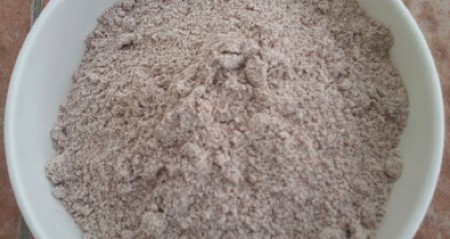By Nadia Marshall
What is Raggi?
Raggi, also known as 'finger millet' is a popular cereal crop grown throughout Africa and Asia. It is native to the Ethiopian Highlands but was introduced to India 4000 years ago and is grown in the Himalayas. It is generally purchased as a very fine pinky/brown flour which can be prepared as breads, dosas, porridges, puddings and cakes. It is an amazing flour and has a naturally delicious taste... a little like subtle cocoa so you don't even need to use spices with it. When it is roasted in ghee it even looks like melted chocolate!
What are its qualities?
From an Ayurvedic perspective, raggi has the following qualities...
Rasa: Sweet
Virya: Heating
Vipaka: Sweet
Qualities: Dry, Light
Actions on the doshas: Balances Kapha, increases Vata and Pitta in excess
Action on the mind: Rajasic/Sattvic
What are its medicinal qualities?
From an Ayurvedic perspective, raggi (like other millet) is considered Sweet, Warming, Dry and Light. This makes it an unusual grain because it has the satisfying, nourishing effect of the Sweet taste but at the same time is light, easy to digest and can antidote the damp stickiness that can result from eating other heavier grains (like wheat). Due to its light, warming and drying effect, raggi is used as ‘food medicine’ in the treatment of high Ama, high cholesterol, dull Agni, diabetes, excess weight, oedema and other excess Kapha (mucous/fluid) conditions. If eaten in excess it may aggravate Vata or Pitta but if cooked with a little oil and/or milk and some cooling spices (like cardamom), it is can be transformed into a relatively tridoshic grain.
The Western viewpoint.
Raggi is rich in vitamins, minerals and fibre. In comparison to rice and wheat it is also quite high in protein. It is particularly high in thiamine, calcium and iron and also the essential amino acid, methionine, so is commonly used in Asia for feeding growing infants. It has a very low glycaemic index, is alkaline and is gluten free.
How do you eat it?
We mainly eat our raggi as a porridge or pudding. With its naturally sweet taste and custard-like consistency, it lends itself to sweet dishes rather than savoury. But, you can also use it to make pancakes (hot cakes) and in the Ayurvedic Kitchen, Stephen has come up with an awesome Raggi and Polenta cake that is not unlike a baked cheesecake!
Why do I love it?
I love Raggi because it reminds me of chocolate! I first had it in India while doing panchakarma and we referred to our raggi porridge as ‘cocoa porridge’... it was our most anticipated breakfast by far!
Should anyone avoid eating it?
People with thyroid problems may wish to avoid eating raggi on a daily basis as it is believed to contain some goitrogen properties.
Where do you get it from?
Raggi flour isn't widely available in Australia but you should be able to pick it up from your local India grocer. If they haven't got it, ask them to order it in... it is well worth it!! If you live locally, we sell it at the clinic.
Enjoy xxx
Love
Nadia x
References:
“Ayurvedic Cooking for Self-Healing” by Vasant Lad
http://www.isfea.in/home/ragi-red-millet/
http://nutrihealfoods.blogspot.com.au/2011/09/millet-as-part-of-daily-alkaline.html




